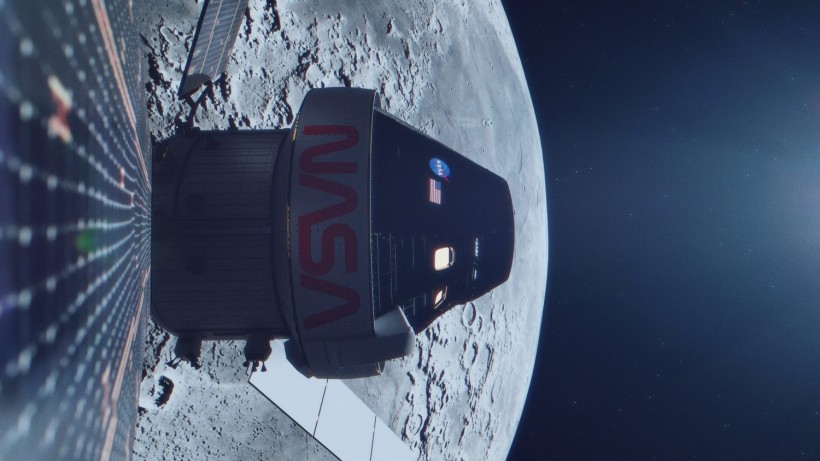NASA's Orion capsule is close to coming home after making its closest approach to the Moon during its second engine burn, which lasted for 207 seconds. The spacecraft soared 79.2 miles above the lunar surface, the closest flyby of the Artemis I mission.
The ground team waited patiently for communication after it was lost for a while. Orion capsule linked back with the ground crew at 12:14 pm ET, which confirms that the burn was as expected and is now on its way back to Earth.

Orion spacecraft in space with its four solar arrays spread widely.
Orion Successfully Conducts Engine Burn
NASA's Orion spacecraft flew behind the Moon once more to capture more photos of Earth and its nearest neighbor before firing up its engines to set it on course back home in the final stages of the Artemis I mission, according to Fox Weather's report.
It is the spacecraft's final close approach, traveling at speeds around 4,800mph as it swept by the Moon's far side. The Orion capsule also captured Earth rising on the horizon as it swung around the lunar surface. The spacecraft is built with a suite of cameras streaming back views of its journey to the Moon and back on Earth.
The recent maneuver of the spacecraft is called the return-powered flyby (RPF) burn, in which the orbital maneuver engine fired for 3 minutes and 27 seconds. It is expected to splash down on the Pacific Ocean on December 11 after 25.5 days in space.
NASA managers in Mission Control at Johnson Space Center in Houston voted for the engine to burn 20 minutes before it. They said the spacecraft had also flown over some Apollo landing sites during its mission before the ground crew lost communication with Orion for about 30 minutes.
Orion's view of the lunar craters and features, as well as Earth, was breathtaking and the next time a view like this will be available will be taken by NASA astronauts after orbiting the Moon during the Artemis II.
Record-Breaking Orion Capsule
On Orion's return to Earth, NASA plans to host another live stream at 5 pm ET to discuss the results of the return-powered flyby engine burn and the recovery of the spacecraft as it splashdown on the Pacific Ocean.
Since its launch, the Orion capsule has broken many records in spaceflight. MailOnline reported that it arrived at its destination on November 21 after traveling 230,000 miles in five days and zoomed over the landing sites of previous lunar missions: Apollo 11, 12, and 14.
Moreover, it flew farther than any spacecraft built for humans at around 40,000 miles beyond the Moon's far side. But the first record the Orion broke was when it snapped a stunning 'blue marble' of Earth nine hours into its epic journey around the Moon. The image marks the first human-made spacecraft to see the view since the last Moon mission about 50 years ago.
Due to the Artemis I mission, Orion now holds the record for the spacecraft with the longest spaceflight duration without docking to a space station and returning faster and hotter than any space vehicle.
The Artemis I mission will be followed by a crewed mission of the Artemis II, estimated to be launched in 2024. It could lead the first woman and person of color to land on Moon on the next Artemis mission.
RELATED ARTICLE: NASA's Artemis I Performs Lunar Flyby on the Sixth Day of Its Mission, Passing by Apollo Landing Sites
Check out more news and information on Artemis Program in Science Times.














